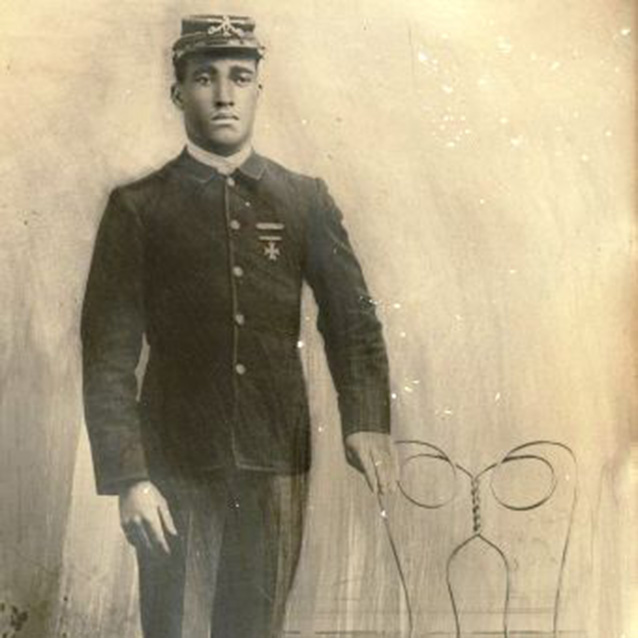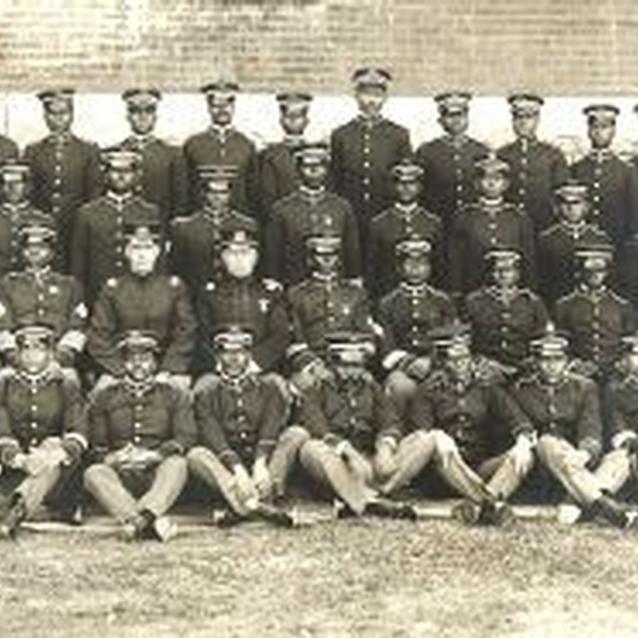African American regiments had been formed during the Civil War, most falling under the moniker United States Colored Troops, but for the first time in the history of the United States soldiers of African American descent could serve in the peacetime army. The Act of 1866 authorized the formation of two cavalry and four infantry "colored" units. They were designated the 9th and 10th United States Cavalry regiments, and the 38th, 39th, 40th, and 41st United States Infantry regiments, and were organized under white officers between the summers of 1866 and 1867.
The 9th United States Cavalry

Library of Congress
The formation of the 9th United States Cavalry initially took place in Louisiana, with its first recruits enlisting in August of 1866. Seven months later, when the regiment marched into Texas, it numbered 885 enlisted men. On June 29, 1867, four companies of the 9th, under the command of Lieutenant Colonel Wesley Merritt, reoccupied the abandoned post at Fort Davis, Texas. Merritt and the 9th Cavalry had a sizeable job ahead of them. In addition to helping to construct a new post, they had to contend with the Apache and Comanche Indians.
The primary concern of the regiment while at Fort Davis was the protection of travelers and the mail on the San Antonio-El Paso Road. For this reason, small detachments of men were placed at a number of stage stops, while other troops scouted and patrolled the vast Trans-Pecos region of western Texas. In September 1875, the 9th Cavalry transferred to New Mexico. However, during the years spent at Fort Davis, the regiment helped build the post into one of the largest in the state.
The 10th United States Cavalry
Organization of the 10th United States Cavalry proceeded at a slower pace than that of the other African American regiments, due in part to the lack of officers and the insistence of its commander, Colonel Benjamin Grierson, to enlist only men who met his very high standards. Undaunted, though, as the small regiment guarded Kansas Pacific Railroad work crews in the summer of 1867, they quickly became involved in a series of fights with the Cheyenne. Soon, the regiment saw duty in Colorado and Oklahoma and engaged in skirmishes with the Kiowa and Comanche.
In 1873, five companies of the regiment arrived in Texas. Two years later Company H was ordered to Fort Davis. For the next ten years, units of the 10th served at the post, which ultimately became headquarters for the regiment in 1882.
A major campaign involving the 10th Cavalry occurred in 1879-1880 when the Apache leader Victorio and a number of followers fled the Fort Stanton reservation in New Mexico and began raiding in western Texas and northern Mexico. The campaign called for the largest concentration of soldiers ever assembled in the Trans-Pecos area. Six companies of the 10th Cavalry and one company of the 24th Infantry guarded water holes and patrolled the region. Major confrontations occurred at a watering hole south of Sierra Blanca called Tinaja de las Palmas and at Rattlesnake Springs. These two engagements halted Victorio and forced him to retreat to Mexico where he and many of his kinsmen were killed by Mexican troops in October 1880.
The 24th United States Infantry

Library of Congress
In 1869, the army consolidated the infantry regiments. The 38th and 41st became the 24th United States Infantry, while the 39th and 40th combined to form the 25th United States Infantry. Companies of the new 24th Infantry served at Fort Davis from 1869 to 1872 and again in 1880. Guarding stage stations and constructing roads and telegraph lines throughout western Texas and southeastern New Mexico, the regiment chased members of the elusive Apache, Comanche, and Kiowa tribes. Although rarely seeing action, Company H was involved in the Battle of Rattlesnake Springs that ultimately forced the Apaches under Victorio to retreat to Mexico in the summer of 1880.
After serving in Texas, the 24th Infantry transferred to the Indian Territory, in what is now Oklahoma, with headquarters at Fort Sill. Here its duties included overseeing the thousands of Native Americans held on reservations and keeping settlers out of the territory. The regiment moved to New Mexico and Arizona in 1888 where it again found itself in the role of a sentinel guarding Apaches and protecting settlers.
The 25th United States Infantry
The 25th Infantry began its existence in Louisiana and Mississippi performing routine garrison duties. Within a short period of time, the regiment received orders to proceed to Texas where its companies found themselves scattered far and wide to posts in the western parts of the state. Scouting, escort and guard details, and road building soon became regular assignments for the members of the 25th Infantry.
Companies of the 25th arrived at Fort Davis in July 1870 and served at the post until July 1880. One of their most important tasks involved construction of 91.5 and miles of telegraph line from Fort Davis to Eagle Springs, which is located near present-day Sierra Blanca, Texas. The line served as the vital communications link used by Colonel Benjamin Grierson of the 10th United States Cavalry during the Victorio Campaign.
In 1880, the regiment was transferred to the Dakota Territory where its duties initially were similar to those performed at Fort Davis. Soon the regiment settled into performing routine garrison tasks; however this tranquil state was jarred when the regiment was sent to Montana in 1888. Ordered into the field, the soldiers of the 25th Infantry found themselves participating in the Pine Ridge Campaign of 1890-91.
The early 1890s saw the men of the 25th Infantry restoring peace in a mining district in Idaho where labor unions had declared open war on mine owners. The regiment, along with the 10th Cavalry, then spent time guarding trains on the Northern Pacific Railroad after labor troubles erupted in 1894.
The Seminole-Negro Indian Scouts
The men who enlisted in the Seminole-Negro Indian Scouts proved to be some of the toughest to serve in the frontier army. Descendants of African Americans who had intermarried with the Seminole Indians in Florida, the Scouts had escaped slavery in the United States and were living in Mexico when they were recruited in 1870.
The Scouts operated primarily out of Forts Clark and Duncan and saw combat in extremely rugged conditions on both sides of the border. During 26 expeditions, the Scouts engaged in 12 battles without losing a single man in combat. They never numbered more than 50 men at a time, yet four of the Seminole-Negro Indian Scouts were awarded the Medal of Honor. They continued to serve in the army until 1914.
Proudly They Served
Their mission was the same - to protect the mail and travel routes, control Indian movements and gain knowledge of the terrain. Surmounting obstacles of harsh living conditions, difficult duty, and racial prejudice, the men who served in the African American regiments and in the Seminole-Negro Indian Scouts, gained a reputation of dedication and bravery. Stationed continuously on the frontier from the 1860s to the 1890s, they played a major role in the peaceful settlement and development of the American West.
African American regiments would later serve in the Spanish-American War, Philippine Insurrection, Mexican Punitive Expedition, World War I, World War II, and the Korean War. In the mid-1950s, the last of the African American units was finally desegregated
Last updated: August 11, 2017
